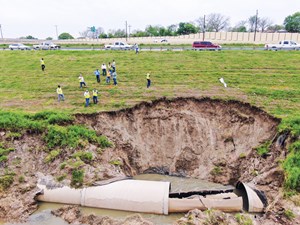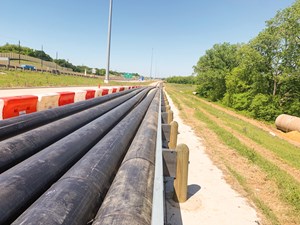December 2020 Vol. 75 No. 12
Rehab Technology
The River and the Highway: How an Interceptor Failure Produced Solutions
By Reyna Johnson and John Van Hoosier
Very few are unacquainted with the truth of Murphy’s Law: “What can go wrong, will go wrong.” Even fewer infrastructure engineers would disagree with one small change to the age-old law: “What can go wrong, will go wrong, especially when too many existing utilities coexist in a narrow corridor adjacent to a river.”
During the spring of 2020, at the onset of the COVID-19 pandemic, this became a firsthand experience for the Trinity River Authority of Texas (TRA). A 104-inch-diameter fiberglass reinforced polymer gravity interceptor, tucked tightly between the West Fork of the Trinity River and Interstate 30, experienced a critical failure.
A major asset for TRA, this interceptor is just upstream of its largest wastewater treatment facility, where the first hint of trouble was detected thanks to the unintentional sacrifice of endeavoring beavers found on the bar screens.
This 104-inch-diameter interceptor, built in 2008 to replace two parallel, reinforced concrete interceptors, 45 and 66 inches in diameter, experienced a longitudinal failure. While no formal investigation was conducted, it was generally agreed to be the result of a slope stability failure due to additional fill placed above the interceptor for the construction of an outer service road within the interstate right-of-way.
Additionally, pipe stability was further compromised by the river cutting into the bank over time. While the interceptor was originally built 110 feet from the nearest shoulder of the interstate, at the time of failure, the shoulder of the installed access/frontage road was only 55 feet away from the pipe centerline. The soil placed during the interstate widening exceeded the stability angle of the fill material.
Emergency repair
Following the beaver-provided early warning, the owner acted immediately to address the failure and contain the flow within the pipe. Lockwood, Andrews & Newnam, Inc. (LAN), a national planning, engineering and program management firm, was tasked with aiding and providing recommendations on an emergency repair.
Working remotely during various COVID-19 shelter-in-place orders, LAN coordinated with multiple design disciplines to develop the pipe embedment and slope restoration design. Efforts were made to first repair the pipeline under live flow, but the volume, proximity of the river, and slope stability complicated such an installation and presented too much risk.
Accordingly, the repair solution required coordination for service road lane closures to lay bypass piping that could handle an average daily flow of approximately 55 million gallons per day. A significant quantity of fill was delivered to the site to restore the failed slope around the pipe and to keep the river out of the excavation.
Ultimately, the failed pipe was removed and over the course of two months, the 104-inch interceptor was successfully replaced with a new, concrete encased pipe and the slope was properly restored and protected.
Long-term solution
TRA, aware of the presumed cause of the failure, was concerned with over-deflection of the existing interceptor remaining within the interstate right-of-way. While the failure occurred 55 feet away, at some locations, the widened interstate was only 12 feet from the pipe centerline with more than 15 feet of additional fill placed on the pipe from its original installation.
When TRA ordered multi-sensor inspection of the 104-inch interceptor all through the right-of-way, these concerns were corroborated. The inspection found that the interceptor deflection upstream of the pipeline failure exceeded industry standards. With this information in hand, TRA opted to replace the existing interceptor within the interstate right-of-way to mitigate future risk of a similar failure.
Several options were evaluated to utilize the existing interstate right-of-way corridor to install the replacement interceptor by either trenchless or open-cut construction. The trenchless option was deemed too costly with an extended construction schedule due to the associated large-diameter tunnel. Likewise, the open-cut option presented significant risk with the physical constraints of a narrow corridor and deep installation.
Beyond concerns with cost and schedule, both options needed to contend with other obstacles. The 45- and 66-inch parallel interceptors, which were replaced by the 104-inch diameter interceptor in 2008, were not removed at that time. Using an open cut or trenchless option would require their removal at locations near the widened interstate. Additionally, a detention pond within the interstate right-of-way further decreased the realistic workspace needed for the installation of any replacement through the corridor.
Another concern existed with incoming 54- and 84-inch interceptors that connect to the 104-inch pipe along the length of interceptor requiring replacement. Numerous improvements to both interceptor systems over the course of decades resulted in a convoluted connection point described by some in TRA operations as a “spaghetti bowl.” Attempting to utilize the existing corridor would further exacerbate any solution to cleaning up this connection.
Alternate alignment
Numerous site visits and meetings were held to develop a solution to utilize the existing corridor. Ultimately, TRA decided to relocate the section of the interceptor alignment outside this existing corridor, as shown in Figure 6. This alignment circumvented any conflict associated with the installation of a replacement interceptor in this narrow corridor by simply routing the interceptor to the opposite side of the river.
This reroute commenced at a point upstream, outside the interstate right-of-way, crossed the river, and continued to a point where it crossed again and terminated at a point along the existing 110-inch interceptor unaffected by the widened interstate. While this option required two inverted siphon crossings, bank stabilization and additional easements, it provided a better hydraulic connection to the intersecting interceptor. It also rerouted the interceptor away from the flow path of the river (to avoid conflicts from future bank erosion) and allowed the owner to abandon the existing interceptor within the interstate right-of-way.
Lessons learned
The emergency repair satisfied the temporary solution for a pipe that failed due to development and natural changes in the flow path of the river cutting into the bank. Also, the new, long-term solution with a realignment will minimize risk to this asset in the future for TRA.
The experience, however, provides a few key takeaways that can benefit all involved in pipeline planning, design, construction and operation:
- The future is uncertain. Future development outside an owner’s control can still have severely negative impacts on their assets. While we cannot design for every unknown, we should always consider potential impacts from reasonable growth projections.
- Be attentive to change. When that uncertain or unplanned change does come (in this case, in the form of interstate expansion and an additional 15-feet of fill), we may have reason to provide input into the plans of others.
- Evaluate life cycle cost. The permanent relocation now in design has an estimated construction cost of $20 to $25 million, but this investment does not simply replace one asset with another. The relocation improves hydraulics, provides better accessibility for operations and maintenance and, most importantly, reduces operational risk.
The successful emergency repair cost more than $2 million and consumed TRA resources for more than two months, and the up and downstream investigation showed that future structural failure could be anticipated. The decision to proactively replace these sections represents long-term asset management, as compared to reactive maintenance.
The planned reroute totals 4,160-linear feet, and the replacement is currently in design. With construction anticipated to start in the summer of 2021, TRA (and the rest of those beavers) will be able to rest a little easier at night or when driving along the West Fork of the Trinity River. •
REYNA JOHNSON, P.E., and JOHN VAN HOOSIER, E.I.T., are engineers at Lockwood, Andrews & Newnam, Inc. (LAN), a national planning, engineering and program management firm. They can be reached at ROJohnson@lan-inc.com and JPVanhoosier@lan-inc.com, respectively.






Comments